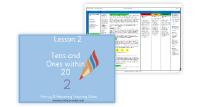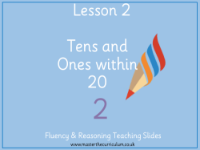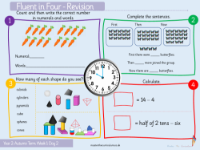Place value - Tens and ones within 20 - Planning

Maths Resource Description
In the initial stages of Year 2, students are introduced to the concept of tens and ones within the number range of 20. The lesson plan includes a variety of resources such as differentiated worksheets, teaching slides, and concrete resources like base 10 blocks or counters to support the learning process. Key vocabulary terms like 'tens', 'ones', 'ten frame', 'count on', and 'complete' are essential to the lesson, and children are encouraged to visit a specific website for vocabulary cards and definitions. The lesson starts with a small step starter that requires children to answer 'fluent in four' questions and practice spelling 'teen' numbers, with a particular focus on the correct spelling of eleven, twelve, thirteen, and fifteen.
During the class, children recap their previous understanding that numbers from 11 to 19 consist of '1 ten and some more', recognising that 10 and 20 are composed purely of tens. The use of base 10 equipment helps them visualise numbers as 'sticks and bricks', with a line representing a ten and a dot representing a one. Through partner work and practical activities, students work with ten frames and counters to create 'teens' numbers, reinforcing their understanding of the number structure. They are encouraged to verbalise their findings using stem sentences to become familiar with the concepts of 'tens' and 'ones'. Key questions guide the students to explore the place value further, addressing common misconceptions such as confusing the value of digits within a number. The lesson aims to ensure that students can represent teen numbers using ten frames, understand the value of counting, and recognise the difference between tens and ones.



